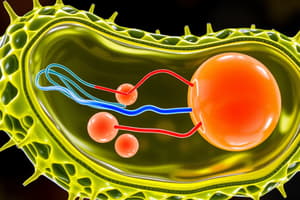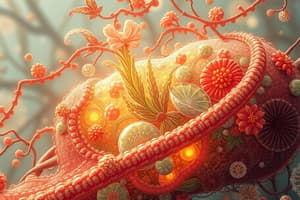Podcast
Questions and Answers
What is the primary energy source utilized in active transport mechanisms?
What is the primary energy source utilized in active transport mechanisms?
- FADH2
- ATP (correct)
- NADH
- Glucose
Which statement accurately describes a concentration gradient?
Which statement accurately describes a concentration gradient?
- It is unaffected by changes in temperature.
- It signifies the difference in concentration across a space. (correct)
- It drives the movement of molecules from low to high concentration.
- It represents equal distribution of molecules throughout a space.
How do phagocytosis and pinocytosis differ?
How do phagocytosis and pinocytosis differ?
- Phagocytosis involves liquid intake, while pinocytosis involves solid particles.
- Both processes involve the same mechanism of transport.
- Phagocytosis engulfs large particles, whereas pinocytosis engulfs small particles and fluids. (correct)
- Phagocytosis is carried out by all cells, while pinocytosis is limited to specific cells.
What effect does a hypertonic solution have on a cell?
What effect does a hypertonic solution have on a cell?
What is the significance of osmosis in cellular processes?
What is the significance of osmosis in cellular processes?
What fundamental difference exists between prokaryotic and eukaryotic cells?
What fundamental difference exists between prokaryotic and eukaryotic cells?
What role do ribosomes play in a cell?
What role do ribosomes play in a cell?
What does the endosymbiont theory propose?
What does the endosymbiont theory propose?
What is the main role of the Golgi apparatus in eukaryotic cells?
What is the main role of the Golgi apparatus in eukaryotic cells?
Which component of the cytoskeleton is primarily involved in cell division?
Which component of the cytoskeleton is primarily involved in cell division?
What process describes the uptake of large particles by a cell?
What process describes the uptake of large particles by a cell?
Which of the following is a characteristic feature of eukaryotic cells?
Which of the following is a characteristic feature of eukaryotic cells?
What happens to a cell in a hypotonic solution?
What happens to a cell in a hypotonic solution?
What is the primary function of ribosomes in a cell?
What is the primary function of ribosomes in a cell?
Which type of junction is responsible for direct communication between neighboring cells?
Which type of junction is responsible for direct communication between neighboring cells?
What is the significance of glycosylation in protein processing?
What is the significance of glycosylation in protein processing?
What role do integrins play in cellular function?
What role do integrins play in cellular function?
What defines action potential in neurons?
What defines action potential in neurons?
Which of the following best describes the extracellular matrix (ECM)?
Which of the following best describes the extracellular matrix (ECM)?
What is a primary function of the endoplasmic reticulum (ER)?
What is a primary function of the endoplasmic reticulum (ER)?
How do microfilaments contribute to cell function?
How do microfilaments contribute to cell function?
What distinguishes a prokaryotic cell from a eukaryotic cell?
What distinguishes a prokaryotic cell from a eukaryotic cell?
Flashcards
Passive Transport
Passive Transport
Moving molecules across a membrane without using energy. Think of water flowing downhill.
Concentration Gradient
Concentration Gradient
The difference in concentration of a substance across a membrane.
Phagocytosis
Phagocytosis
Engulfing large particles like bacteria. Think of a cell 'eating'.
Osmosis
Osmosis
Signup and view all the flashcards
Prokaryotic Cells
Prokaryotic Cells
Signup and view all the flashcards
Protein Synthesis
Protein Synthesis
Signup and view all the flashcards
Endosymbiont Theory
Endosymbiont Theory
Signup and view all the flashcards
Golgi Apparatus
Golgi Apparatus
Signup and view all the flashcards
Cell membrane (plasma membrane)
Cell membrane (plasma membrane)
Signup and view all the flashcards
Endocytosis
Endocytosis
Signup and view all the flashcards
Exocytosis
Exocytosis
Signup and view all the flashcards
Facilitated diffusion
Facilitated diffusion
Signup and view all the flashcards
Tonicity
Tonicity
Signup and view all the flashcards
Hypotonic Solution
Hypotonic Solution
Signup and view all the flashcards
Hypertonic Solution
Hypertonic Solution
Signup and view all the flashcards
Isotonic Solution
Isotonic Solution
Signup and view all the flashcards
Chloroplast
Chloroplast
Signup and view all the flashcards
Endoplasmic Reticulum (ER)
Endoplasmic Reticulum (ER)
Signup and view all the flashcards
Study Notes
Active vs. Passive Transport
- Active transport moves molecules against their concentration gradient, requiring energy (ATP). Example: sodium-potassium pump.
- Passive transport moves molecules along their concentration gradient, without energy input. Example: oxygen diffusion across cell membranes.
Concentration Gradient & Diffusion
- A concentration gradient is the difference in concentration of a substance across a space.
- This difference drives diffusion, which is the natural movement of molecules from high to low concentration until equilibrium is reached.
Phagocytosis vs. Pinocytosis
- Phagocytosis ("cell eating") involves engulfing large particles, like bacteria by white blood cells.
- Pinocytosis ("cell drinking") involves taking in small particles and fluids, such as nutrient absorption by intestinal cells.
Hypertonic Solution Effects
- A hypertonic solution has a higher solute concentration than the cell.
- This causes water to leave the cell through osmosis, leading to cell shrinkage (crenation).
Osmosis
- Osmosis is the diffusion of water across a selectively permeable membrane from a region of low solute concentration to a region of high solute concentration.
- It is crucial for maintaining cell volume, nutrient uptake, and waste removal.
Prokaryotic vs. Eukaryotic Cells
- Prokaryotic cells lack a nucleus and membrane-bound organelles.
- Eukaryotic cells possess a nucleus and membrane-bound organelles , and are generally larger and more complex.
Ribosomes
- Ribosomes are essential for protein synthesis.
- They translate genetic code from mRNA into amino acid sequences to build proteins.
Endosymbiont Theory
- The endosymbiont theory proposes that mitochondria and chloroplasts originated as free-living prokaryotic cells that were engulfed by ancestral eukaryotic cells.
- Supporting evidence includes their double membranes, unique circular DNA, and ribosomes similar to prokaryotes.
Golgi Apparatus
- The Golgi apparatus modifies, sorts, and packages proteins and lipids received from the endoplasmic reticulum.
- It adds carbohydrates to proteins (glycosylation), and sorts them for transport to other organelles or secretion outside the cell.
Cytoskeleton Components
- The cytoskeleton is composed of microfilaments (actin filaments) responsible for muscle contraction and cell motility.
- Intermediate filaments provide structural support and maintain cell shape.
- Microtubules are involved in cell division and intracellular transport.
Studying That Suits You
Use AI to generate personalized quizzes and flashcards to suit your learning preferences.




